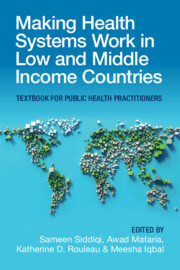 Making Health Systems Work in Low and Middle Income Countries
Making Health Systems Work in Low and Middle Income Countries The Path from Data to Decision
from Section 2 - Transforming Health Systems: Confronting Challenges, Seizing Opportunities
Published online by Cambridge University Press: 08 December 2022
This Chapter describes principles of information management for health systems and the need to focus on key data items required to improve individual and population health. It discusses the collection and analysis of relevant, high-quality data and the importance of agreeing on health programme aims before defining the minimum data set. We review the derivation of health indicators, focusing on WHO indicators. Many indicators rely on linking data from different sources, which requires accurate personal identifiers. Data is useless unless reports based on it can be shared and understood, so data analysts should use different visualization techniques to facilitate and support user decisions such as self-service dashboards. We also review the many high quality, open source, free to use data capture, analysis and data sharing tools that can support health systems, concluding that it is rarely necessary to develop an information system from scratch. Finally, while big data analytics, artificial intelligence and machine learning capture many headlines, health system can achieve much using simple tools to capture relevant, high-quality data and turn it into actionable knowledge to support their decision makers.
To save this book to your Kindle, first ensure [email protected] is added to your Approved Personal Document E-mail List under your Personal Document Settings on the Manage Your Content and Devices page of your Amazon account. Then enter the ‘name’ part of your Kindle email address below. Find out more about saving to your Kindle.
Note you can select to save to either the @free.kindle.com or @kindle.com variations. ‘@free.kindle.com’ emails are free but can only be saved to your device when it is connected to wi-fi. ‘@kindle.com’ emails can be delivered even when you are not connected to wi-fi, but note that service fees apply.
Find out more about the Kindle Personal Document Service.
To save content items to your account, please confirm that you agree to abide by our usage policies. If this is the first time you use this feature, you will be asked to authorise Cambridge Core to connect with your account. Find out more about saving content to Dropbox.
To save content items to your account, please confirm that you agree to abide by our usage policies. If this is the first time you use this feature, you will be asked to authorise Cambridge Core to connect with your account. Find out more about saving content to Google Drive.